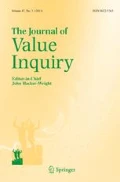Notes
See Ruth Faden and Tom Beauchamp, A History and Theory of Informed Consent (Oxford: Oxford University Press, 1986); see also Joel Feinberg, Harm to Self (New York: Oxford University Press, 1986); Paul Appelbaum, Charles Lidz and Alan Meisel, Informed Consent: Legal Theory and Clinical Practice (New York: Oxford University Press, 1987); Gerald Dworkin, The Theory and Practice of Autonomy (Cambridge: Cambridge University Press, 1988); and Tom Beauchamp and James Childress, Principles of Biomedical Ethics, 6th ed. (New York: Oxford University Press, 2001).
James Taylor, “Autonomy and Informed Consent: A Much Misunderstood Relationship,” The Journal of Value Inquiry, Vol. 38, No. 3 (2004), p. 384; see also James Taylor, ed., Personal Autonomy: New Essays on Personal Autonomy and iIs Role in Contemporary Moral Philosophy (New York: Cambridge University Press, 2005); and John Christman, ed., The Inner Citadel: Essays on Individual Autonomy (New York: Oxford University Press, 1989).
See James Taylor, Practical Autonomy and Bioethics (New York: Routledge, 2009), pp. 141–156.
Taylor, “Autonomy and Informed Consent,” op. cit., p. 386.
See Taylor, Practical Autonomy and Bioethics, op. cit., pp. 137–138.
See Joseph Raz, The Morality of Freedom (New York: Oxford University Press, 1986), pp. 372–374; see also Thomas May, “The Concept of Autonomy,” American Philosophical Quarterly, Vol. 31, No. 2 (1994).
See Steven Joffe and Robert Truog, “Consent to Medical Care: The Importance of Fiduciary Consent,” in Franklin Miller and Alan Wertheimer, eds., The Ethics of Consent: Theory and Practice (Oxford: Oxford University Press, 2010), p. 352.
Marc Rodwin, “Strains in the Fiduciary Metaphor: Divided Physician Loyalties and Obligations in a Changing Health Care System,” American Journal of Law and Medicine, Vol. 21, No. 2–3 (1995), pp. 243–244.
See Jukka Varelius, “On Taylor on Autonomy and Informed Consent,” The Journal of Value Inquiry, Vol. 40, No. 4 (2006), p .455; see also Taylor, Practical Autonomy and Bioethics, op. cit., pp. 134–135.
See Taylor, “Autonomy and Informed Consent,” op. cit., p. 387.
Faden and Beauchamp, op. cit., p. 253.
See ibid., p. 252.
See Carl Schneider, The Practice of Autonomy (New York: Oxford University Press, 1998); see also William Strull, Bernard Lo and Gerald Charles, “Do Patients Want to Participate in Medical Decision Making?,” The Journal of the American Medical Association, Vol. 252, No. 21 (1984).
See Taylor, “Autonomy and Informed Consent,” op. cit, p. 391.
I would like to thank James Taylor, Nic Southwood, Jeremy Shearmur, and the anonymous referees from The Journal of Value Inquiry for their helpful comments on an earlier draft of this paper.
Author information
Authors and Affiliations
Corresponding author
Rights and permissions
About this article
Cite this article
White, L. Understanding the Relationship Between Autonomy and Informed Consent: A Response to Taylor. J Value Inquiry 47, 483–491 (2013). https://doi.org/10.1007/s10790-013-9385-x
Published:
Issue Date:
DOI: https://doi.org/10.1007/s10790-013-9385-x

